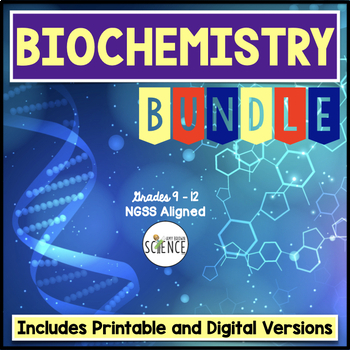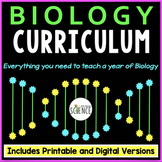Biochemistry and Macromolecules Unit Bundle
- Zip
- Google Apps™

What educators are saying
Products in this Bundle (13)
showing 1-5 of 13 products
Bonus
Also included in
- This NO PREP, PRINTABLE, EDITABLE, AND DIGITAL Biology Curriculum contains everything you need for an entire year of Biology! For less than $3 a day, you can save your time, energy, and sanity. Each of the 20 Complete Units includes a teaching PowerPoint presentation, notes, labs, homework assignmenPrice $525.00Original Price $988.18Save $463.18
Description
This complete teaching unit on "Biochemistry: The Chemistry of Life" includes everything you need to teach this unit to your life science or biology students. Many of the resources are available in BOTH printable and digital formats. Resources include an 88-Slide Powerpoint presentation packed with colorful and interesting photographs, teacher notes, printable and digital student notes, 4 labs, 4 homework assignments, 3 jeopardy review games, 4 quizzes, organic compounds card sort game, crossword puzzle, and a final unit exam.
From the engaging PowerPoint to the final unit test, this bundle contains loads of NO PREP materials that are ready to be used with your students. Many of the resources in this bundle are available in paperless digital formats for use in Google Drive, Google Classroom, Microsoft OneDrive, or similar.
What is included in this bundle? ( Items marked with ** have both printable and digital versions.)
- Biochemistry Powerpoint and Notes **
- 4 Homework Assignments and Study Guide **
- Biochemistry Crossword Puzzle
- Set of 3 Biochemistry Jeopardy Review Games
- Biochemistry Unit Test **
- Organic Compounds Mix/Match Game **
- Biochemistry Quizzes Set of Four **
- Organic Compounds Review (Advanced) **
- Lab: Testing for Organic Compounds in Foods
- FREE Enzyme Catalase Lab Activity
- Lab: The Release of Heat in an Enzymatic Reaction
- Lab: Cells, pH and Buffers
- Organic Compounds Graphic Organizer
Teacher Guide containing tips for implementing the resources, suggestions for sequencing, and alignment to NGSS standards is also included.
Editable. Printable. Digital.
Teacher Answer Key is included for each resource.
The topics covered include the following:
- The Nature of Matter: Atoms, subatomic particles, mass and charges of the subatomic particles.
- Elements: Definitions, isotopes, radioactive isotopes, practical uses of radioactive isotopes, the nature of compounds.
- Chemical Bonds: Definitions and examples of ionic and covalent bonds, polar molecules, polar covalent bonds, nonpolar covalent bonds.
- Properties of Water: The polarity of water molecules, hydrogen bonding, hydrogen bonds in ice, liquid water, and water vapor, cohesion and adhesion.
- Mixtures, Solutions, and Suspensions: Definitions, homogeneous and heterogenous solutions, solute, solvent.
- Reasons why water makes life possible.
- Acids, Bases, and pH: The pH scale, definitions of acids and bases, buffers, why buffers are essential to the life of a cell.
- Carbon Compounds: The difference between organic and inorganic compounds, the characteristics of carbon that allow for the building of a large variety of biological molecules.
- Functional Groups: Definition of functional group and their role in chemical reactions. Four common functional groups are covered: Hydroxyl, carboxyl, amino, and phosphate groups.
- Macromolecules; Definition of macromolecule, groups of macromolecules, polymerization, monomers, polymers, condensation reactions, hydrolysis reactions
- Carbohydrates: Examples of carbohydrates, characteristics of carbohydrates, building blocks or monomers of carbohydrates, functions of carbohydrates in cells, monosaccharides, disaccharides, polysaccharides, starch, glycogen, cellulose.
- Lipids: Examples of lipids, characteristics of lipids, building blocks or monomers of lipids, nonpolar nature of lipids, fatty acids, glycerol, saturated and unsaturated fats, triglycerides, phospholipids, waxes.
- Proteins: Examples of proteins, characteristics of proteins, building blocks or monomers of proteins, the structure of amino acids, dipeptides, polypeptides, the relationship between shape and function of proteins.
- Enzymes: Definitions and the role of enzymes in cells, equation for how an enzyme works, substrate molecules, active site, products.
- Nucleic Acids: Brief introduction to nucleic acids, two type of nucleic acids, building blocks of nucleic acids.
For updates about sales and new products, please follow my store:
My TpT Store: Amy Brown Science
You can find me at these locations as well:
My Blog: Amy Brown Science.com
Instagram: @AmyBrownScience






